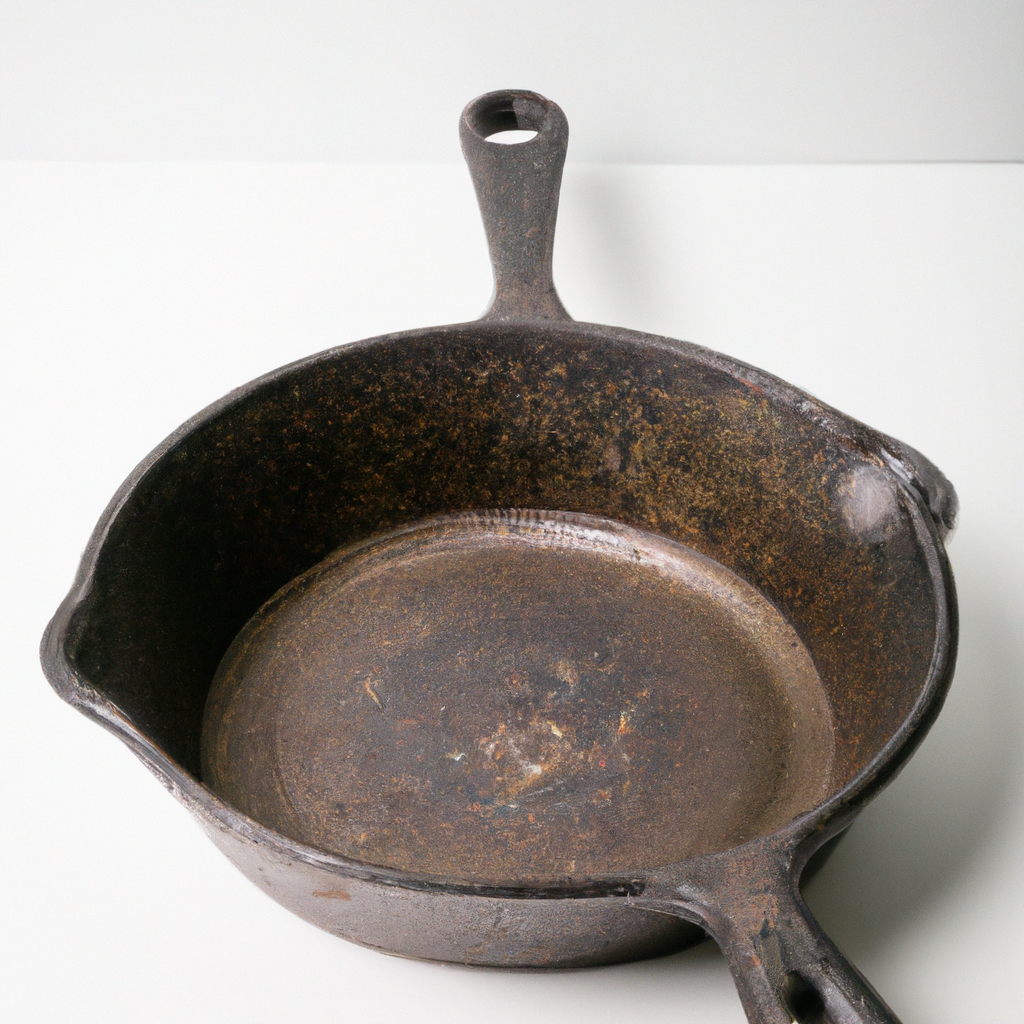Once upon a time in the culinary kingdom, there stood a humble yet powerful warrior in the kitchen realm: the cast iron cookware. Armed with its unrivaled heat retention and unwavering durability, this stalwart soldier has been cooking up masterpieces for generations. But like any warrior, even the mightiest of cast iron needs a proper secret seasoning technique to unleash its full potential. In this article, we shall embark on a culinary adventure, unveiling the sacred rituals and tricks to properly season cast iron cookware. So grab your apron, sharpen your spatula, and prepare to delve into the realm of cast iron enchantment.
1. Mastering the Sizzling Symphony: Unveiling the Secrets of Properly Seasoning Cast Iron Cookware
There is something magical about the sizzling sound of food hitting a well-seasoned cast iron skillet. It’s a symphony of flavors waiting to be unraveled. If you’re new to the cast iron cooking world, mastering the art of seasoning your cast iron cookware is essential. Proper seasoning not only ensures a natural non-stick surface but also enhances the taste of your dishes with each use. Here are a few secrets to help you achieve cast iron culinary perfection.
1. Scrub and Season: The Initial Ritual
Before your cast iron can truly shine, it needs a clean slate. Start by scrubbing your new or neglected skillet with hot water and a stiff brush to remove any manufacturing residue or old seasoning. Once clean, make sure to thoroughly dry your cookware.
Next comes the seasoning process. It’s as simple as applying a thin layer of cooking oil or melted vegetable shortening to the entire surface, inside and out. Don’t forget the handle! Place it upside down in a preheated oven at 350°F for an hour, allowing the oil to polymerize and create that coveted non-stick surface. Repeat this process a few times, and your cast iron will be well-seasoned and ready for culinary adventures.
2. Ditch the Soap: Cleaning Tips
Contrary to popular belief, you don’t need to use soap to clean your cast iron after each use. Soap can strip away the seasoning, so it’s best avoided. Instead, opt for hot water and a non-abrasive brush or sponge.
If you’re dealing with stubborn residues or stuck-on bits, use a salt scrub. Sprinkle coarse salt on the cooking surface, use a damp cloth to create a paste, and gently scrub. Afterwards, rinse with hot water and dry thoroughly.
3. Heat, Oil, Repeat: Maintenance Routine
To keep your cast iron in top shape, it’s important to maintain its seasoning regularly. After each use, while the skillet is still warm, wipe it with a thin layer of oil to ensure it stays seasoned. This essential step prevents rust and keeps the non-stick surface intact.
For stubborn residue, heat the skillet and add a splash of water to loosen it. Scrape off the debris with a spatula, wipe clean, and immediately apply a thin coat of oil to preserve the seasoning.
Remember, every time you use your cast iron cookware, it adds another layer of flavor and character. With patience and proper care, your cast iron will become your trusted kitchen companion, creating symphonies of sizzling perfection for years to come.
2. From Rust to Glory: Unlocking the Art of Seasoning Cast Iron Pans for Culinary Greatness
Seasoning cast iron pans is an ancient art, but mastering it can unlock a world of culinary greatness. Cast iron pans have been treasured for generations, with their unrivaled ability to distribute heat evenly and maintain consistent temperatures. From rusted and neglected to seasoned to perfection, these pans have the potential to transform your cooking experience.
So, how do you go from rusted and neglected to a culinary masterpiece? Here are some tips and tricks to help you unlock the art of seasoning your cast iron pans:
1. Scrub away the rust: Start by giving your cast iron pan a thorough scrubbing to remove any rust or debris. Use warm water and a stiff brush or scrubbing pad to gently scrape away the rust. Repeat this step as many times as necessary until the surface is clean and smooth.
2. Dry it thoroughly: After cleaning, it’s crucial to dry your cast iron pan completely to prevent further rusting. Place it in a preheated oven at a low temperature for about 10-15 minutes or until it’s completely dry. Alternatively, you can dry it on the stovetop over low heat.
3. Apply a thin coat of oil: To season your cast iron pan, apply a thin coat of oil all over its surface, inside and out. You can use vegetable oil, canola oil, or even flaxseed oil. Be sure to wipe off any excess oil with a paper towel to avoid a sticky or greasy residue.
4. Bake it to perfection: Place your oiled cast iron pan upside down in a preheated oven at a moderate temperature, typically around 350°F (175°C). Bake it for about an hour to allow the oil to polymerize and bond with the pan’s surface, creating a slick and durable seasoning.
5. Repeat and build layers: Seasoning is a process, not a one-time event. To achieve a well-seasoned cast iron pan, repeat the oiling and baking steps at least three to four times. Each layer of seasoning will enhance the pan’s nonstick properties and make it more resilient.
6. Proper care: Once you have successfully seasoned your cast iron pan, remember to care for it properly. Avoid using harsh detergents or scrubbing pads that may remove the seasoning. Instead, use a gentle brush or scrubbing pad and hot water. After cleaning, dry the pan thoroughly and apply a thin layer of oil to keep it in prime condition.
Unlocking the art of seasoning cast iron pans takes time, patience, and practice, but the rewards are exceptional. With a beautifully seasoned cast iron pan in your kitchen arsenal, you’ll be able to effortlessly cook up culinary creations that will dazzle your taste buds and impress your guests. So, grab your cast iron pan, embrace the journey, and unlock the true potential of this kitchen essential!
3. A Culinary Ritual: Step-by-Step Guide to Achieving Flawless Seasoning for Your Beloved Cast Iron Cookware
Embarking on a culinary journey often involves creating your own traditions and rituals in the kitchen. One such ritual that has stood the test of time is the art of seasoning cast iron cookware to achieve a flawless cooking surface. In this step-by-step guide, we will unveil the secrets to mastering this ancient technique, ensuring your cast iron pans remain a beloved treasure in your kitchen.
Step 1: Cleaning and Preparing
The first step in achieving flawless seasoning is to clean your cast iron cookware thoroughly. If there are any food residues or rust, gently scrub them away using a non-abrasive brush or sponge. Rinse the pan with warm water and pat it dry with a clean cloth.
Step 2: Apply the Seasoning Oil
Once your cast iron pan is dry, it’s time to apply the magic ingredient – a thin layer of seasoning oil. Popular options include vegetable oil, flaxseed oil, or even lard. Using a paper towel, slightly dampen it with the oil and generously rub it all over the inside and outside of the pan. Ensure every nook and cranny is coated evenly.
Step 3: The Baking Process
Now comes the exciting part – the baking process. Preheat your oven to a temperature of around 400°F (200°C). Place your oiled cast iron pan upside-down on the middle rack of the oven and let it bake for one hour. This allows the oil to polymerize and create a smooth, non-stick surface.
Step 4: Cool and Store
Once the baking time is complete, turn off the oven and allow the cast iron pan to cool inside without opening the door. As it cools, the seasoning will continue to set, enhancing the durability and non-stick properties of your cookware. Once fully cooled, you can store your beloved cast iron pan or proceed to the next step – cooking mouth-watering meals!
By following these steps, you’ll learn that seasoning your cast iron cookware is not just a practical necessity but an art form. With each use, your pan will develop a rich patina, adding flavor and character to your dishes. So, embrace this culinary ritual and elevate your cooking experience to new heights with your flawless, well-seasoned cast iron pan by your side.
4. Harnessing the Magic: Unleashing the Power of Proper Seasoning to Transform Your Cast Iron Cookware
When it comes to cooking with cast iron, proper seasoning can truly work wonders. The art of seasoning allows you to transform your cast iron cookware into a non-stick surface that rivals modern alternatives. Here are some tips and tricks to help you harness the magic of seasoning and unlock the full potential of your cast iron:
1. Selecting the Right Oil:
Choosing the right oil for seasoning is crucial. Traditional options like vegetable oil, canola oil, or flaxseed oil work well due to their high smoking points. Avoid using low-smoke point oils like olive oil that can leave a sticky residue on your cookware.
2. Scrubbing and Cleaning:
Before seasoning, make sure your cast iron is properly cleaned. Using a non-abrasive sponge, gently scrub away any food remnants or built-up residue. Rinse with warm water and thoroughly dry the cookware to prevent any rust from forming.
3. The Seasoning Process:
Generously coat your dry cast iron with a thin layer of oil. Be sure to cover the entire surface, including the handles and edges. To achieve a smooth and even coating, you can use a paper towel or simply rub the oil in using your hands. Repeat this process if needed.
4. Heating and Curing:
Preheat your oven to a moderate temperature, usually around 350°F (175°C). Place your oiled cast iron upside down on the oven’s center rack to allow any excess oil to drip off. Bake for an hour to polymerize the oil, creating a hard and durable seasoning layer.
5. Maintenance and Care:
- After each use, use a mild dish soap and water to clean your cast iron. Avoid using harsh cleaning agents or soaking your cookware for an extended period.
- Thoroughly dry your cast iron after washing to prevent any moisture-related issues.
- Apply a light coating of oil to your cast iron after each use to maintain the seasoning. This helps protect against rust formation and keeps your cookware in its best condition.
- Avoid using metal utensils that may scratch the seasoning. Opt for wooden, silicone, or stainless steel utensils instead.
By following these steps and developing a consistent seasoning routine, you’ll soon witness the remarkable transformation of your cast iron cookware. With its new non-stick surface and enhanced heat retention, your cast iron will become your go-to kitchen workhorse, capable of producing restaurant-quality meals.
Congratulations! You now have a complete understanding of how to properly season cast iron cookware. You can look forward to enjoying meals cooked in this effective, long-lasting cookware for many years to come. Enjoy the amazing and flavorful dishes that await you!


